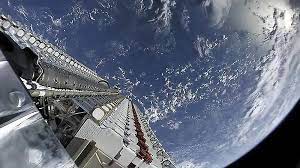Starlink: What Is It?
Mark DiPietro
Sports Editor
Elon Musk has made a name for himself for being at the forefront of innovation for the past decade, leading companies that develop technologies ranging from self-driving electric cars to flamethrowers. But one of the most promising projects is one that has flown mostly under the radar of the general public, Starlink.
Starlink is a branch of an established Musk-owned company, SpaceX, which aims to provide widespread internet access through low-orbit satellites. They aim to do this by expanding on the concept of satellite internet in order to cover more real estate than the now widely popular fiber-optic connection. Starlink differs from traditional satellites in its lack of ground equipment. The method as previously conceived needs a large receiver on the ground to take the signal from a satellite in orbit to transmit to the user’s home through their receiver mounted on their home. Musk has replaced this by building a network of satellites lower in the atmosphere so the network can be connected decentralized, spanning across all devices and connecting to homes directly. This allows Starlink to grow rapidly, potentially providing internet coverage to the entire globe within years as the expansion of the network is not reliant on the construction of large ground receivers and customers needing to be in the vicinity of these receivers.
Currently, Musk has successfully launched almost 1,800 satellites, currently providing coverage to all of the U.S. and Canada, and most western European nations. Most experts estimate that around 10,000 satellites would be needed to cover the whole globe using this method, but some predict that as much as 42,000 are needed. While there is still a lot of work to be done, the expansion and functionality of the network in such a short time show that Starlink’s scalability is likely very large.
In terms of speed, Starlink is mediocre. It is certainly quite far from the innovational masterpiece of a few decades ago, fiber optics. Utilizing the physical properties of glass and operating at the speed of light, fiber optics is, as of now, the fastest internet in the market at 2000 Mbps. Current tests put Starlink’s speed at around 100-140 Mbps, a significant fraction of speed. However, Musk claims that once fully implemented, Starlink will operate at 40% faster than a standard fiber optic cable. The claim is quite optimistic but has convinced a substantial amount of investors as Starlink already boasts a customer count of 100,000.
This is probably because, for most consumers, Starlink’s key advantage is in its width, not its depth. If the system can be implemented properly, it can bring the internet to places that it is next to impossible to bring to through conventional means today. The required costs of building a large Satellite ground receiver or laying the fiber optic framework have set global internet access at decades in the future. But under this new development, Montana ranches to rural African villages could be connected virtually for the first time ever. It is these underserved customers in which Musk is targeting. At a low cost of a $499 installment fee and $99 monthly fees, it is hard to believe that, given a working network is available, there will not be a substantial amount of revenue available for SpaceX.
There are still some limitations. As mentioned previously, the speed is at the back of the pack in terms of alternative options for most consumers and no number of tweets promising it faster will deliver as much as tangible, third-party tests. Another issue is regulation. Launching into a low atmosphere presents a few unique legal issues on the rights of private companies to do so. That, as well as these low flying devices, have been known to block the viewing of planetary bodies in the past and with Musk planning to launch many times more devices, the eye of regulatory agencies has been drawn.
Despite these risks and limitations, the potentiality of these systems is cosmically important. For years culture has sung the praises, and complaints, of the brainchild of the 21st century, the internet. With all the hubbub surrounding how fast the internet has grown, there are still places on earth in which it is unavailable. Musk would erase these gaps and cover every inch of the earth with internet access. Despite all the important accomplishments Musk has and will undertake in his life, this may be a crowning achievement in an already decorated entrepreneurial career. Whether he can successfully add this to the proverbial trophy case is yet to be seen.
Contact Mark at dipietma@shu.edu

